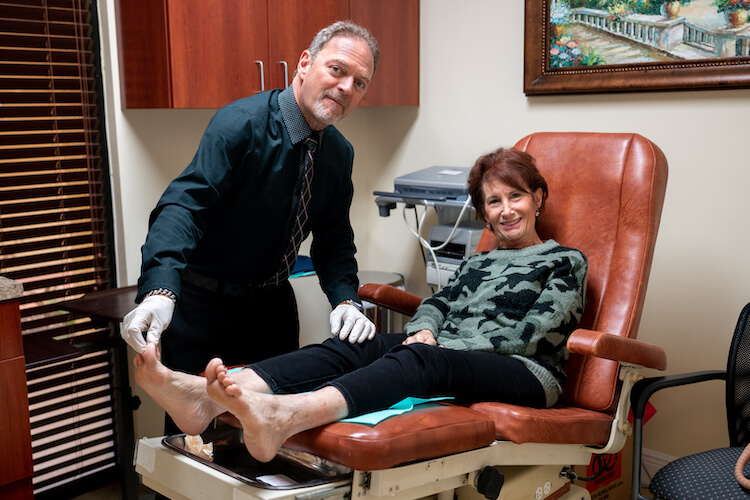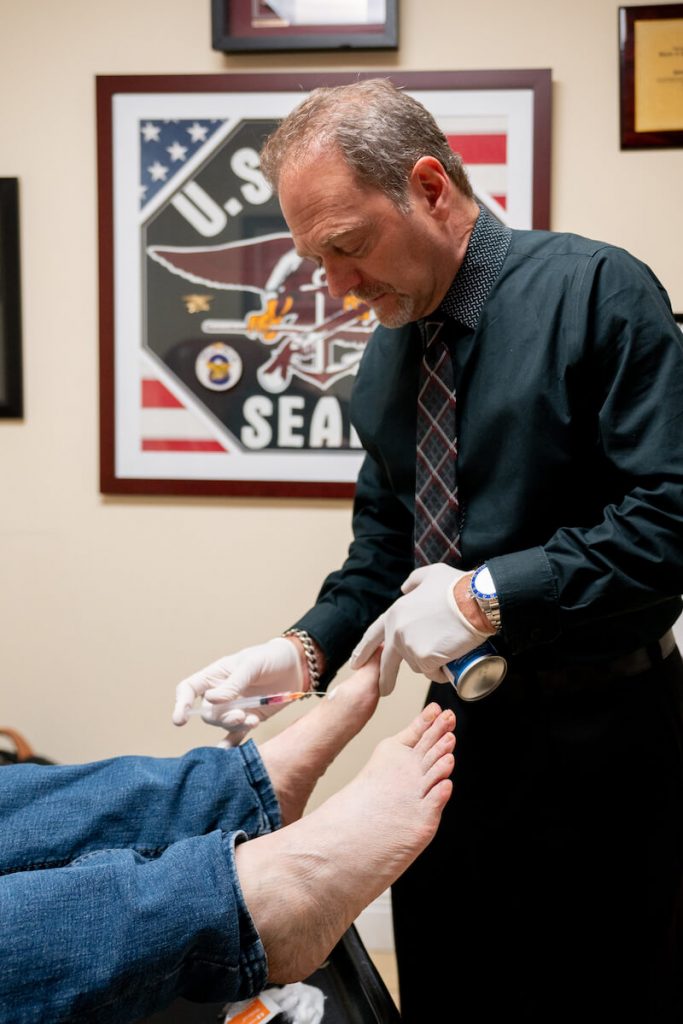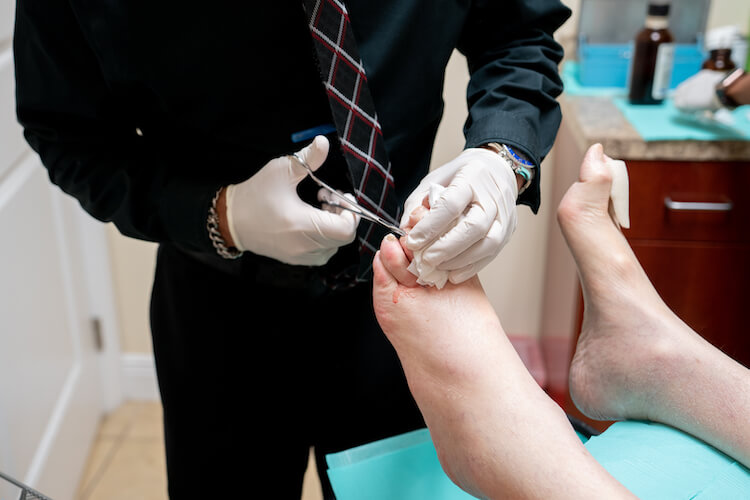If you have any kind of problem with your feet, ankles or the structure of your lower legs, you really shouldn’t wait to see a foot specialist. A foot & ankle specialist is called a podiatrist. They are doctors who are completely devoted to diagnosing and treating the foot and ankle. There is no better doctor than a podiatrist when it comes to anything related to the lower extremities. So, whether you have foot or ankle pain, swelling, numbness or you notice a change in its structure and the way you move OR you just want to be informed on what to look for to ensure your feet and ankles remain healthy and happy, keep an eye on these common signs that tell you it is time to see a podiatrist.

11 SIGNS YOU NEED TO SEE A PODIATRIST (FOOT & ANKLE SPECIALIST)
Here are 13 surefire signs that you need to see a podiatrists.
1. EXCESSIVE & DAY-TO-DAY PAIN
One of the most pronounced signs that you need to see a podiatrist is excessive or day-to-day pain in your feet or ankle.
Toe, Foot or Ankle Injury
With excessive, abrupt pain, you are likely dealing with a toe, foot or ankle injury. It typically happens suddenly, and the pain doesn’t go away. It may be a sprain or a fracture and if it’s not taken care of, you could develop an infection or permanent deformity. So, if you think you have a foot injury, make sure you see a podiatrist for proper diagnosis and treatment.
Limping & Difficulty Walking
Sometimes pain comes on slowly and it is not caused by blunt trauma. It may be dull and mild when you are resting and randomly sharp and excruciating when you step on it. In any case, if it is persistent and it’s enough to make you limp or have difficulty walking, you must see a podiatrist to find out what’s the root cause so you can fix it. It may be an old injury, plantar fasciitis, arthritis or various other conditions. No matter what the cause is, it must be fixed.
If you limp to avoid pain, you can start to develop knee, hip and back pain, and if you limp long enough, you can actually change the structure of your body as your other joints are compensating for your painful foot and ankle to help you move.
Furthermore, if you avoid walking and moving around as you normally would, you could become overweight and unhealthy, which only amplifies the problem.
Heel Pain in the Morning
Heel pain in the morning or heel pain that comes and goes is a common sign of plantar fasciitis. It can also be a sign of a fracture, tendonitis, arthritis, or nerve irritation too. Regardless, you shouldn’t overlook the heel pain, even if it is mild or only in the morning. It could very well worsen over time. So, if you have heel pain, go see a podiatrist and get it fixed right away.
Flat feet
If you have flat feet and you are starting to experience pain on a regular basis (maybe you just started a new fitness routine or you are standing on your feet more than normal), you should go visit a podiatrist as they can help you eliminate the pain. Products like orthotics can stop foot pain caused by flat feet and it is a very easy fix.
There are other types of foot and ankle pain that you may be experiencing, so signs that you should see a podiatrist are not limited to just the above. Chronic pain that lasts for more than a few days isn’t normal and it must be dealt with by a foot specialist. If you have any pain in your foot or ankle that is excessive or daily, address it with a podiatrist immediately.

2. SWELLING
Another clear indicator that you need to see a podiatrist is if your feet or ankle is swollen.
Now, it’s not uncommon for feet to swell a little bit later in the day. In fact, that is natural. However, it is usually not very noticeable and the difference from the morning is negligible.
If you have obvious swelling, swelling in just one foot or ankle, swelling accompanied by pain, or swelling that doesn’t go away, it is imperative that you visit a podiatrist. Swelling is a reaction to an internal or external problem, such as an injury, blood clot, gout, heart and circulation issues, and kidney problems. All in all, it must be addressed straight away.
3. NUMBNESS & DECREASED SENSATION
Numbness can occur from prolonged sitting, having your legs elevated, or external pressure. Everyone experiences the “pins and needle” feeling from time to time. It is entirely normal.
However, if your lower extremities are excessively numb and it’s ongoing, it likely indicates a considerable problem. It is usually a sign of neuropathy (nerve damage, which is most often seen in people with diabetes).
So, if you notice any unfamiliar numbness in your lower extremities, we urge you to visit a podiatrist straight away.
4. BRUISING OR DISCOLORATION OF THE FEET
Numbness can often go unnoticed in those with neuropathy. So, you should keep an eye out for bruising and discoloration in your feet. If you have bruises or redness that can’t be explained, you may have injured yourself without knowing, your foot may even be infected. It’s possible that you weren’t able to feel the injury because your feet lack feeling due to peripheral neuropathy. So, if you have unexplained bruising in your feet or ankle, please see a podiatrist to have it checked out.
A podiatrist will run some tests to see if you have neuropathy and they will also scan your foot for any injuries.
5. STIFFNESS
As with numbness, stiffness in the feet and ankle can occur from time to time, such as after a long day or running or being on your feet all day. However, prolonged and abnormal rigidity is not normal. If your feet feel stiff frequently, it is important that you see a podiatrist. Frequent stiffness in your feet or ankle is a sign of an underlying problem and it can also lead to other issues.

6. CHANGE IN FEET SHAPE & DEFORMITY
Changes in feet shape and deformities can happen gradually or from injuries that are left untreated. The two most common deformities that occur in the feet are bunions and hammertoes. Let’s quickly address each so you know what to look for.
Bunions
Bunions, or Hallux Valgus, is a condition that forms when bone and tissue at the joint of the big toe move out of place. It happens over years and years of abnormal motion and pressure on the big toe joint, forcing it to bend towards the other toes. Over time, it causes a deformity and it can be painful.
To avoid bunions, you should wear the right shoes. If you have pain in your foot that is caused by your shoes, you should visit a podiatrist as they can help you get the right shoes for your feet and they can explain to you how to combat bunions for the long run. This is particularly important for athletes and women who often wear high heels.
If you already have bunions and it is painful, you should visit a podiatrist to see if surgery is right for you.
Hammertoe
Just like bunions, hammertoe is often caused by improper footwear. Hammertoe can typically be fixed without surgery. A podiatrist can help you reduce inflammation and pain and they can make a custom insert to wear inside your shoe. This will ensure it doesn’t get worse. If it is permanently bent, surgery can be done to straighten out the toe. This is something you can discuss with the podiatrist. It’s a simple procedure for a podiatrist, but it isn’t always necessary.
7. OPEN SORE OR WOUND
If you have an open sore or wound on your foot that won’t heal, you must see a podiatrist right away.
Keep an eye out for discoloration around the wound, especially dark colors (serious foot ulcers can cause black tissue or gangrene around the wound). Also, be aware of pain around the area and pay attention to signs of infection.
In any case, if it’s a serious sore or wound and anything is unusual or lasting longer than normal, you should get yourself to a podiatrist pronto.
Open sores and wounds are particularly serious for diabetics, as it takes longer to heal, even if being treated. It must be monitored closely, as diabetics have a higher chance of skin and bone infection, which can lead to amputation.
So, for diabetics, any open sore or wound should immediately be addressed by a podiatrist. However, for those who don’t have diabetes, keep an eye on the sore and wound and if it doesn’t heal at a normal rate or if it gets worse and something doesn’t look right, visit a podiatrist as soon as you can.

8. DRY, CRACKED HEELS
At first, dry and cracked heels may seem harmless, but over time they can bleed and become susceptible to infection. To avoid this, visit a podiatrist for prescription-grade foot cream. This will nip it in the bud quickly.
9. CORNS & CALLUSES
Corns and calluses are areas of thickened dead skin. Although they are typically harmless, they can become painful. If you have corns or calluses that won’t go away and they start to become painful, it’s a sign that its time to see a podiatrist. They will be able to remove them quickly and easily. If you don’t treat it, spending time on your feet will only become more cumbersome. Eventually, it can lead to an open would and infection. There’s no need to wait for a situation like this to develop. Just get it taken care of at your earliest convenience.
10. INGROWN TOENAIL
Ingrown toenails are common and often not taken very seriously. However, they can go from a minor nuisance to extremely painful…
While you can try some home remedies, we recommend visiting a podiatrist as it is much safer and you can prevent the risk of infection. Moreover, they can provide medication for the pain.
Ingrown toenail treatment for a podiatrist is a cinch. You’ll be in and out in no time.
11. FOOT & TOENAIL FUNGUS
Fungal infection of the feet has exponentially risen in the general population thanks to nail salons and gyms. People often treat it with OTC creams, only to have it come back again and again. The over the counter creams typically only suppress the systems. So, if you are fighting against a persistent toenail fungus or athletes foot, visit a podiatrist to get it taken care of once and for all. If you don’t, it can lead to your nails becoming thick and discolored, and possibly infected. This will require laser treatment to remove the fungus or even nail removal.

Note to diabetics:
If you have diabetes, you must be particularly careful of your feet. Check them every day for all of the signs above. Moreover, you should visit a podiatrist at least once or twice a year for a thorough check-up.
Closing note to all:
The signs we discussed here are the most common indicators that you need to see a podiatrist, and oftentimes, multiple signs will accompany each other.
If you are experiencing some other kind of problem with your feet or ankle that we didn’t discuss here, please contact us or visit your local podiatrist.
We urge you to take your feet seriously. They are your base foundation and they are vital to living a happy, healthy, active life.
If you have insurance, the answer to “should you visit a podiatrist” is “why not!”. At Delray Beach Podiatry, we are “in-network”, so we accept every insurance.


No responses yet